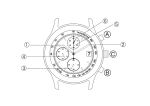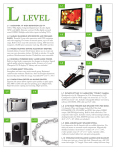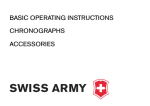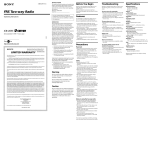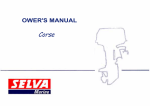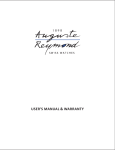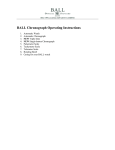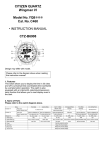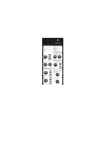Download Wenger/SwissGear Roadster
Transcript
Instructions’ booklet 2 Table of Contens Wenger Watch Components 4 General Features and Components 5 Operating Instructions Standard Three-Hand Watches 6 Chronograph Watches 8 12-hour chronograph with Slide Rule Function (SR) Pilot Series 18 Recalibrating the Timer Hands 22 Traveler Series GMT 25 The 24 Time Zones 30 30-Day Calendar Watches 32 Power Reserve Series 36 12 2nd Time Zone Dual Subdial Watches 40 Day, Date, Month Subdial Watches 42 Swing-Out Compass Watches 44 Dual Time Zone Features 46 Watches with Alarm 47 Additional Features 48 Features on Watch Bracelets 49 Translations of this booklet in • Français • Deutsch • Español to be found on www.wenger.ch/service/booklets 3 4 Wenger Watch Components Movements – Swiss quartz movements. Case Body – All stainless steel or titanium for quality and durability. Water-Resistant – To 30m (99’), 50m (165’) or 100m (330’) for standard watches. To 200m (660’) or 1000m (3300’) for dive watches. Straps/Bracelets – Stainless steel and titanium bracelets feature dive buckles or deployant jewelry buckles. Straps are offered in genuine calfskin leather, specially treated rubberized leather, water-resistant rubber or nylon, or other high-quality materials. Luminous Markers – Hands, markers, and numerals may be overlaid with Super Luminova ® which recharges in seconds when exposed to direct sunlight for extended nighttime visibility. General Features and Components Hour, minute and second hands Bracelet or strap Crown protoctor Military time Crown (used to set date and time) Bezelring Date Case Day 5 6 Position 1 Position 2 Position 3 Setting Time, Day and Date on Standard Watches (see Table of Contents on p. 2-3 for other watches) Important note to assure waterresistance: If the crown of your watch does not pull directly out or if your watch is water-resistant to 200m or more, then you may have a watch with a screw-down crown. Rotate the crown counterclockwise until the crown moves away from the watch. This will set the crown in Position 1. Always screw down the crown after making any adjustments. This is very important as the screw-down crown assures water resistance. 1. Pull out the crown to Position 2 (one «click» out). Rotate crown counterclockwise until the date shows one day earlier than the date you want to set. 2.Pull out the crown to Position 3 (two «clicks» out). Rotate crown so the watch hands move clockwise until the current date shows. Then set the watch hands to the correct time. Turn the watch hands past 12 once if you’re setting the watch for a P.M. time. Push the crown back to Position 1. 3.For a watch with day and date display, pull out the crown of the watch to Position 2, turn it clockwise to change the day and counterclockwise to change the date. 4.Return the crown to the fully depressed Position 1, assuring the crown has been further screwed down on all diver watches. For Watches Without a Date Display 1.To set the time for watch without date display, pull out the crown to Position 2. Turn the crown either clockwise or counterclockwise to set the correct time. 2.Return the crown to the fully depressed Position 1, assuring the crown has been screwed down on all diver watches. 7 8 Features of Chronograph (Stopwatch) Subdials (two or three) Top pusher Crown Bottom pusher Chronograph seconds hand Position 1 Position 2 Position 3 Setting the Time and Date (For Chronos and Pilot Series only) 1.Pull out the crown to Position 2 (one «click» out). Rotate crown counterclockwise until the date shows one day earlier than the date you want to set. 2.Pull out the crown to Position 3 (two «clicks» out). Rotate crown so the watch hands move clockwise until the current date shows. Then set the watch hands to the correct time. Turn the watch hands past 12 once if you’re setting the watch for a P.M. time. 3.Return the crown to the fully depressed Position 1, assuring the crown has been further screwed down on all 200m watches. 9 10 30-Minute Chronograph (Stopwatch) The chronograph feature is a stopwatch which measures minutes, seconds, and 1/10 of a second. It is also capable of measuring split-timed events (timing a continuous event and sub-events simultaneously; e.g., timing an individual lap and an entire race). Note: the 1/10-second timer (right subdial) will not move until the stop button is pushed. It will then record the elapsed 1/10-seconds. 12-Hour Chronograph (Stopwatch) The chronograph feature is a stopwatch which measures hours, minutes, and seconds. It is also capable of measuring split-timed events (timing a continuous event and sub-events simultaneously; e.g., timing an individual lap and an entire race). Stopwatch (30-Minute or 12-Hour) 1.To start the stopwatch, push the top pusher. 2.To stop it, push the top pusher again. 3.Read the seconds, minutes, and hours on the appropriate dials (see the section of this manual that corresponds to your watch for dial identification). 4.To reset the stopwatch to zero, push the bottom pusher. Note: The clock function will continue to operate while using the stopwatch. Using the Split-Timing Function 1.Press the top pusher to start the stopwatch. 2.To read a lap or other intermediate segment of time, push the bottom pusher. The watch hands will stop, but the watch will continue to time the total event internally. 3.To resume timing the total event, push the bottom pusher again. 4.You may repeat this as often as you like. The internal clock will continue to time the total event each time you repeat the process. 5.To stop timing the total event, push the top pusher. 6.Reset the stopwatch to zero by pushing the bottom pusher. 11 12 12-hour chronograph with Slide Rule Function (SR) Inner scale Top pusher 10:00 Crown 30-Minute counter subdial Seconds hand subdial 3:00 Crown Chronograph seconds hand 12-Hour counter subdial Bottom pusher Outer scale Using the 12-hour chronograph with Slide Rule Function (SR) This SR can perform a variety of calculations from currency conversions to multiplication and division problems with 94% accuracy. With the circular slide, you can calculate any conversion of a linear nature with a constant ratio such as ounces to grams, kilograms to pounds, miles to kilometers, etc. Important note: The 10:00 crown features a screw-down mechanism to protect against accidental adjustments. Rotate the crown counterclockwise to move the crown away from the watch. Always screw down the crown after making adjustments. This is vital for protecting your watch against water intrusion. 1.Rotate the 10:00 crown counterclockwise until it moves away from the watch. This will set the crown in Position 2. 13 14 2.Rotate crown until the large arrow on the inner scale is aligned with the number «60» on the outer scale. Notice that all the numbers in the inner and outer scale match up. 3.D ecimal points. Depending on the context of your problem, you will decide whether to read the number “10” on the inner scale as 1, 10, 100 or 1,000. The markers between numbers indicate the calibration. (e.g., the calibration between 10 and 11 are each 0.1 so, 2 calibrations above the 10 will read at 10.2. The calibration between 15 and 16 are each 0.2 so 2 calibrations above the 15 will read as 15.4) Multiplication 1.Set the large 10 with the arrow on the inner scale over the number you want to multiply on the outer scale. (e.g., for 32 x 7 = 224, set the (10/arrow) number opposite the 32 on the outer scale.) 2.Read the result on the outer scale opposite the number you are multiplying by on the inner scale. (e.g., for 32 x 7, read the number on the outer scale opposite 7 on the inner scale). Division 1.Set the number you are dividing by on the inner scale over the number you are dividing on the outer scale. (e.g., for 540 ÷ 12 = 45, set the 12 on the inner scale over 54 on the outer scale.) 2.Read the result on the outer scale opposite the (10/arrow) number on the inner scale. Ratios and Conversions When the numbers on the outer scale and the inner scale match, the ratio between the two scales is 1:1. When you rotate the inner scale so that the number (10/arrow) is opposite the 20 on the outer scale, the ratio between the two scales is 2:1. This feature is useful to convert any linear conversion like currencies or weight/length from standard to metric. Simply find how many units of one measurement equals one unit of the other and match up that number with the number (10/arrow). 15 16 For example, 1 oz = 28.35 grams, rotate the inner scale until the (10/arrow) number is below the 28.35 on the outer scale. Now all the numbers on the outer scale become grams and all the numbers on the inner scale become ounces. As an example, look at 85 on the outer scale. It is pointing to 30 on the inner scale. Making a decimal point adjustment to 3.0 you now know that 3 oz. are almost 85 grams. Currency Conversion Suppose the currency rate for the Swiss Franc is SFR 1.30 to $1.00 USD. Rotate the inner scale to set (10/arrow) number opposite the 13 on the outer scale. The outer scale becomes Swiss Francs and the inner scale reflects the USD equivalent (e.g., to convert SFR 4.00 to USD, look at the number on the inner scale opposite the 40 on the outer scale and you will see the number 31. Therefore, SFR 4.00 = $3.10 USD). Miles and Kilometers You can convert miles to kilometers or the reverse and subsequently miles/ hour to kilometers/hour and the reverse. 1.Rotate the inner scale until the «STAT» arrow is set opposite the number of miles you want to convert to km on the outer scale. 2.Read the corresponding km value on the outer scale that is set opposite the «MPH/KM» arrow on the inner scale. (e.g., to convert 25 mph to kilometers per hour, set the STAT arrow opposite 25 on the outer dial. The MPH/ KM arrow is pointing to 40 which indicates 25 MPH = 40 K/H.) 3.To convert from miles to km, do the reverse. 17 18 Pilot Series 12-Hour Subdial Minute Subdial 2nd Time zone Top pusher Seconds timer 9:00 Crown Internal rotating bezel Chronograph seconds hand 3:00 Crown Bottom pusher Using the Internal Rotating Bezel 1.Elapsed Time a.Rotate the 9:00 crown counterclockwise until the zero mark (triangle with orange dot) is at the minute hand. b.T he position of the minute hand in relation to the zero mark on the bezel will indicate the total number of minutes elapsed. 2.Dual Time Zone a.Rotate the 9:00 crown until the hour hand points to the 2nd time zone time shown on black bezel ring. (eg., local time is 1:00 and second time zone time is 7:00; rotate black bezel ring until «7» lines up with «1» on the dial). b.T he time in the 2nd time zone can be read by looking at the numerals in the black ring. 19 20 3. Countdown Timer a.Using the minute hand as a starting point, rotate the 9:00 crown to position the triangle with orange dot at the desired finish point. b.T he minute hand will indicate how many minutes are remaining on the internal rotating bezel. Using the Tachymeter The Tachymeter is the miles or kilometer per hour indicator along the outer edge of the watch face. It is meant to be used in conjunction with the chronograph feature to measure speed over a distance of one mile or one kilometer. 1.B egin with timer hands at zero. 2.Start the chronograph when the object in motion moves from the starting point. 3.Stop the chronograph when the object in motion has traveled one mile or one kilometer. 4.T he seconds hand chronograph timer (the large seconds hand) will have advanced to a point on the Tachymeter. The corresponding number indicated by the Tachymeter is the average speed (in MPH or KMH) the object has traveled over the mile or kilometer distance. Note: The object must have traveled exactly one mile or one kilometer for the tachymeter to be accurate. Using the Telemeter The Telemeter (distance in kilometers indicator along the outer edge of the watch dial is used for measuring distances with the help of sound. Example in the situation of a thunderstorm: 1.B egin with Chronograph hands (stop watch) at zero. 2.Start the Chronograph hand when observing a flash of lightning. 21 22 3.Stop the Chronograph hand when hearing the thunder. 4.T he Chronograph hand will point to a numeral on the telemeter scale, indicating the approximate distance (in km) between the observer and the position of the lightning (current location of thunderstorm). Recalibrating the Timer Hands The timer hands are preset to begin at zero. It is possible that over time the hands will not begin at zero. If this happens you will need to recalibrate the hands. You may also set them to begin at a different point (see below). For Pilot Series 1.Pull out the crown to Position 3. 2.Hold both pushers down simultaneously for 2 seconds; the chronograph seconds hand will rotate to indicate that the corrective mode is activated. Release the pushers. 3.Adjusting the seconds hand: Hold or tap the top pusher until the desired time is reached. 4.Adjusting the minute/hour counters: Tap the bottom pusher to switch to the minute/hour adjusting mode. Then hold or tap the top pusher until the desired time is reached. 5.Return the crown to the fully depressed Position 1. For 30-Minute Chronographs 1.To recalibrate the 30-minute timer, pull the crown out to Position 3. Press the top pusher repeatedly until seconds hand is in desired starting position. 2.To recalibrate the seconds hand timer, pull the crown out to Position 2. Press the top pusher repeatedly until seconds hand is in desired starting position. 3.To recalibrate the 1/10-second timer, pull the crown out to Position 2. Press the top pusher repeatedly until 1/10-seconds hand is in desired starting position. 23 24 4.Return crown to Position 1 when finished. For 12-hour chronograph with Slide Rule Function (SR) 1.Pull the 3:00 crown out to Position 3. 2.Hold both pushers down simultaneously for 2 seconds; the chronograph seconds hand will rotate to indicate that the corrective mode is activated. Release the pushers. 3.Adjusting the seconds hand: Hold or tap the top pusher until the desired time is reached. 4.Adjusting the hour counter: Tap the bottom pusher to switch to the hour adjusting mode. Then hold or tap the top pusher until the desired time is reached. 5.Adjusting the minute counter: Tap the bottom pusher to switch to the minute adjusting mode. Then hold or tap the top pusher until the desired time is reached. 6.Return the crown to the fully depressed Position 1. Traveler Series GMT Hour hand 25 Minute hand Inner bezel 2:00 Crown (screw-down) Second hand 4:00 Crown Second time zone hand 26 Setting the Time and Date on GMT-Watches 1.Pull out the 4:00 crown to Position 2 (one «click» out). Rotate crown clockwise until the date shows one day earlier than the date you want to set. 2.Pull out the 4:00 crown to Position 3 (two «clicks» out). Rotate crown so the watch hands move clockwise until the current date shows. Then set the watch hands to the correct time. Turn the watch hands past 12 once if you’re setting the watch for a P.M. time. 3.Return the crown to the fully depressed position. Position 1 Position 2 Position 3 Setting the 2nd Time Zone Important note: The 2:00 crown features a screw-down mechanism to protect against accidental adjustments. Rotate the crown counterclockwise to move the crown away from the watch. Always screw down the crown after making adjustments. This is vital for protecting your watch against water intrusion. 1.Rotate the 2:00 crown counterclockwise until the crown moves away from the watch. This will set the crown in Position 2. 2.Rotate the 2:00 crown (be patient, it’s not as easy to rotate as the 4:00 crown) clockwise until a city in the same time zone as your local time zone appears (e.g., Central Europe = Paris). 3.Pull out the 4:00 crown to Position 2 (one «click» out). Rotate the 4:00 crown counterclockwise to set the hour hand to the local time on the 24hour inner bezel. 27 28 Note: The inner bezel has a 24-hour display. Therefore, when setting the local time, make sure that 8 a.m. is set as 08.00 and 8 p.m. is set as 20.00. 4.Rotate the 2:00 crown once more until a city in the desired time zone appears in the cut-out at the 9 o’clock position of the dial. 5.T he second time zone hand will now indicate the time for this time zone. This hand rotates once every 24 hours and indicates the time on the 24hour display of the outer bezel. 29 Checking Additional Time Zones Once the watch has been set as described, you can check other time zones at any time by rotating the 2:00 crown. Note: Certain time zones do not recognize daylight saving time (DST). You must take this difference of +/- one hour into account when reading the second time zone or whenever you set the second time zone (see table on pages 30-31). Position 1 Position 2 Inner bezel 30 The 24 Time Zones City London Paris Cairo Moscow Abu Dhabi Karachi Dhaka Bangkok Hong Kong Tokyo Sydney Noumea Time zone DST (daylight saving time) = Greenwich Mean Time (GMT) yes yes yes yes no no no no no no yes no + 1h + 1h + 2h + 4h +5h +6h +7h +8h +9h +10h +11h 31 City Auckland Samoa Honolulu Anchorage Los Angeles Denver Chicago New York Caracas Rio Azores Reykjavik Time zone DST (daylight saving time) +12h -11h -10h -9h -8h -7h -6h -5h -4h -3h -1 -0h yes no no yes yes yes yes yes yes yes yes no 32 30-Day Calendar Series Hour hand Inner rotating bezel (calendar date) Minute hand 2:00 Crown (screw-down) Seconds hand 4:00 Crown Outer bezel (day of the week) 24-Hour second time zone inner dial Second time zone hand Strap or bracelet Setting the Time and Date 33 Follow instructions on p.6ff. Setting the Second Time Zone 1.Pull out the 4:00 crown to Position 2 (one «click» out). Rotate crown counterclockwise to set the second time zone hand to the local time on the 24hour second time zone inner dial. 2.Return the crown to the fully depressed position. Note: The inner dial has a 24-hour/ Position 1 military time display. Therefore, when setting the local time, using the inner 24h dial zone, make sure that, as an example, 8 a.m. is set as 08.00 and 8 p.m. is set as 20.00. Position 2 34 Position 1 Position 2 Setting the Day and Date on the Inner Rotating Bezel Important note: The 2:00 crown screws down to prevent accidental reset. Rotate the crown counterclockwise until the crown moves away from the watch. Always screw down the crown after making any adjustments. This is very important as the screw-down crown assures water resistance. 1.Rotate the 2:00 crown counterclockwise until it moves away from the watch. This will set the crown to Position 2. 2.Using the 2:00 crown, rotate the inner bezel to set the calendar posi- 35 tion «1» opposite the corresponding day of the week on the outer bezel. (e.g. if December 1st is a Monday, rotate the inner bezel to set the calendar position «1» opposite «MO» on the outer bezel. Now it’s easy to see, as an example, that December 25th lands on a Thursday and the 31st is on a Wednesday.) 3.Return the crown to the fully depressed Position 1, assuring the crown has been screwed down. 36 Power Reserve Series Power Reserve/ alarm indicator 2nd Time zone hand (thin arrow) Top pusher Seconds hand subdial Crown Day subdial Bottom pusher Alarm hand (broad arrow) Position 1 Position 2 Position 3 Setting the Day of the Week, Time and Date 1.Pull out the crown all the way out to Position 3. Rotate crown counterclockwise, advancing the watch hands until the current day shows (in the subdial over the 6 o’clock position). Continue to rotate the crown counterclockwise until the correct time is displayed. Turn the watch hands past 12 once if you’re setting the watch for a P.M. time. Push the crown back to the fully depressed Position 1. 2.Pull out the crown to Position 3, then push in the crown one «click» to Position 2. Rotate crown clockwise and the date will change in the date window. Return the crown to the fully depressed Position 1. 37 38 Setting the Alarm, Activating It and Checking the Power Reserve The Alarm indicator hand is the hand with the larger of the two arrows. This hand indicates the time at which the alarm would sound once activated. 1.Pull out the crown to Position 3, then push in the crown one «click» to Position 2. Turn the crown counterclockwise. The alarm indicator hand will rotate. You will note 15-minute increments on the dial (15, 30, 45) to help you set a precise time for the alarm to activate between the hour markings. 2.Push the top pusher. The small indicator hand in the left subdial will indicate the battery strength for the alarm and movement. It will then move automatically to the «ON» position. The alarm will now activate at the time set. 3. Return the crown to position 1. 4.W hen the alarm sounds, push the top pusher to turn it off. Note: The Alarm can be turned off or deactivated at any time by pushing the top pusher until the left subdial’s indicator hand moves to the «OFF» position. Setting the 2nd Time Zone Indicator The outermost area of the dial has hour markings 1 thru 24. This is for the second time zone which is indicated by the hand with the thinner of the two arrows. 1.Push the bottom pusher and hold it for a few seconds. You will hear a brief signal. Release the pusher. 2.Push the bottom pusher and hold it again. The arrow indicator will revolve around the dial. By releasing the button and then pushing it in again momentarily, small forward adjustments can be made. If you hold the pusher down, adjustments can be made more quickly. Once released and after a few seconds, you will hear the brief signal again indicating that the 2nd time zone indicator is now set. 39 40 2nd Time Zone Dual Subdial Watches Minute hand Hour hand 2nd Time zone minute hand 2nd Time zone hour hand Date Crown Second hand 2nd Time zone pusher Setting the 2nd Time Zone 1.D epress the 2nd time zone pusher for at least 2 seconds and release. The minute hand will automatically advance one minute. 2.D epress the pusher again and hold it down to advance the minute and hour hands. The longer the pusher is depressed, the faster the time will advance. 3.If you do not depress the pusher for 10 seconds your watch will automatically exit the setting mode. 41 42 Day, Date, Month Subdial Watches Hour hand Minute hand Day of week sub-dial Date sub-dial 1 2 3 Crown, crown positions Month sub-dial Second hand Setting the Time, Day and Date 1.Pull out crown to position 2 and rotate crown clockwise. You will notice that every time the date sub-dial hand passes 31, the month sub-dial hand moves forward once. Repeat this action until the current month is set. 2.Rotate crown clockwise for the date and counter-clockwise for the day until the date shows one day earlier than the date you want to set. 3.Pull out crown to position 3. Rotate crown so the watch hands move clockwise until the current date shows. Then set the watch hand to the correct time. Turn the watch hands past 12 once if you’re setting the watch for a P.M. time. 4.Return crown to position 1. 43 44 Swing-Out Compass Watches Setting the Date 1.Pull out the crown to Position 2 (one «click» out). Rotate crown counterclockwise until the date shows one day earlier than the date you want to set. 2.Pull out the crown to Position 3 (two «clicks» out). Rotate crown so the watch hands move clockwise until the current date shows. Then set the watch hands to the correct time. Turn the watch hands past 12 once if you’re setting the watch for a P.M. time. 3.Return the crown to the fully depressed Position 1. Position 1 Position 2 Position 3 45 Operating the Compass 1.Swing-out side of case to reveal compass. 2.L ay the compass on a flat surface for best results. 3.Your compass will adjust to accurately reflect orientation within 30 seconds, the arrow may undergo some movement during this period. Once still, the red arrow will be pointing North. 4.Your compass now accurately reflects your orientation. 1 2, 3, 4 46 Dual Time Zone Features (for 2nd Time Zone Dual Subdial, see p. 40) Note: The second time zone is read in military time (1:00 p.m. = «13», 2:00 p.m. = «14», etc.). The military time hours appear either on the dial, or on some models, on the bezel of the watch. 1.B egin by setting the regular time by following the instructions on pages 6ff. 2.To set the second time zone, pull out the crown to Position 2 (one «click» out) and set the second time zone hand (indicated above in red) by turning the crown clockwise. 3.Return the crown to the fully depressed Position 1, assuring the crown has been screwed down on all diver watches. Watches with Alarm 1.B egin by setting the regular time by following the instructions on pages 6ff. 2.Pull crown out to Position 2. 3.Rotate crown clockwise to set alarm hand (indicated in red) at desired alarm time. 4.Pull out alarm button (located at either 2 o’clock or 11 o’clock) to set alarm. You will hear a brief signal acknowledging that the alarm is set. 5.Return crown (not the alarm button) to Position 1. Alarm will sound when hour hand passes alarm hand. Note: Do not expose watch to moisture when alarm button is pulled out. Push in alarm button to stop alarm at any time. If alarm button is not pushed in, alarm will sound once, pause and then sound ten times and stop. Push alarm button in to stop or alarm will sound again in 12 hours. 47 48 Additional Features (All features may not be available on all models) Rotating Bezel This feature enables you to track elapsed time. 1.Turn the bezel counterclockwise until the zero indicator (60) is at the minute hand. 2.T he position of the minute hand in relation to the zero indicator on the bezel will indicate the total number of minutes elapsed. Unidirectional rotating Bezel (Diver watches) For security reasons, the bezel ring moves in one direction, only. Features on Watch Bracelets (All features may not be available on all models) Deployant (Jewelry) Clasp Deployant closures are used to assure a secure fit of your watch and easy opening and closing. Deployant closures on straps allow for a one-time fitting instead of refitting each time the watch is worn. Deployant Buckles on Bracelets Deployant buckles on bracelets are generally double deployant, or two-sided to hide the buckle and give the bracelet a seamless appearance. 1.Have the watch fitted by a professional jeweler and the appropriate links removed. 2.Gently pull on either side of the clasp to open, or press down to close. 49 50 The symbol with the crossed out disposal bin indicates that this watch shall not be treated as household waste. Please hand over your old or unused watch to the applicable collection point for the recycling of electrical and electronic equipment or bring your old watch to your retailer for appropriate disposal. printed in Switzerland 09/2009 ref. 99600.E 51 Wenger Watch s.a. Oberer Quai 51 CH-2502 Biel/Bienne Switzerland Tel: +41 (0)32 344 04 60 Fax: +41 (0)32 344 04 69 [email protected] www.wenger.ch Cert no. SQS-COC-100061























































